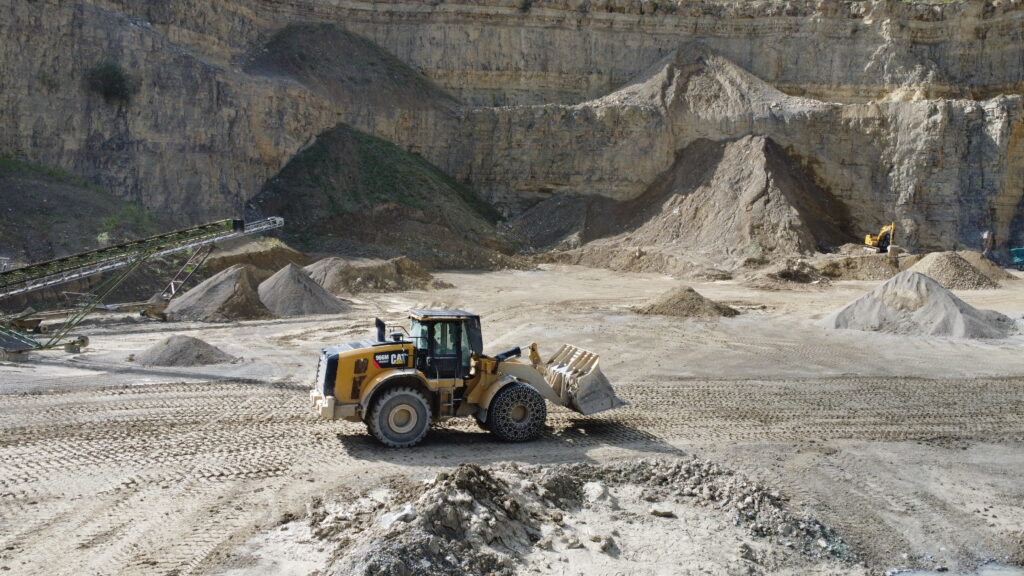Sometimes it is worth taking a regular look out of the office window to find that it is not running smoothly. This happened to mining engineer Andreas Goedecke, who started in 2003 as Managing Director at Kalkwerk Hehlen, which he took over one year later as part of a management buyout. From his work desk, he has a direct view of the adjacent shell limestone quarry in the Weserbergland and noticed that the wheel loader used stood around again and again with the engine running instead of loading material. This drove him and led to the analysis of the production data of the Cat 966M using the fleet management Vision Link together with the service of the Zeppelin branch in Hanover and then to reduce its idle rate to a peak value.

Mining and processing of up to 180,000 tons of ore – and as efficiently as possible: Hehlen Kalkanlage handles this task day after day. Since construction machinery generates a lot of data, it can be a solid basis for profitability analysis and thus business decisions.
“As with the Cat 966M, the data does not lie, it is generated automatically. The standstill with almost 30% inactivity was unsatisfactory and our three regular pilots could not always provide a plausible explanation,”
says Andreas Goedecke.
He wanted to get to the bottom of the matter, because the wheel loader was not in constant motion and fully loaded with a bucket of 4.2 cubic meters. But thanks to Vision Link, he was able to find out the cause. The device was not as productive as they thought, and now they have changed it, so the downtime in two years is on average below 10%. Of course, there are also work interruptions, because in the middle of production a stone got stuck in the crusher or when an exhaust gas cleaning has to be carried out. They cannot do without it, but they are referring above all to obvious downtimes that last longer than five minutes.
Every Monday morning, Andreas can view the data in a report from the previous week and looks at possible outliers. Since employees know this is happening, abnormal idling has improved significantly.
“A different consciousness has developed and you are now paying more attention. Fewer deviations have also meant that he has to ask much less often. However, it is important to communicate positive developments and make it clear to the workforce that it is not about saving fuel alone, but that we cannot give away money during production time, but can save a lot of money, because the wheel loader is more productive during its operating hours”
says Andreas Goedecke.
Based on 2,000 operating hours, 20 percent less idling, assuming an average fuel consumption of 4.3 liters per hour, is around 1,720 liters, which is less. This translates into a saving of 2,500 euros. Based on the rule of thumb that one litre of diesel corresponds to around 2.64 kilograms of CO2, 4.5 tons of CO2 emissions are saved. For comparison, an individual would travel around 360,000 kilometres by train. Aspects of sustainability therefore drive Andreas Goedecke to invest in modern equipment. They want to keep the burden on the environment as low as possible. After 6,000 hours of operation, there is always a fresh breeze in the machine park.
“If something is wrong with a construction machine, it can be a gut feeling or be based on experience, but if you look at the consumption data and thus the costs, then you have the black on white”
says the mining engineer.
As a further step, he wants to go even deeper in the future and also examine the data of the other Cat construction machines such as a Cat deep bucket excavator 320FL in the open pit and a Cat caterpillar D6N XLP in the overburden to make raw material production even more efficient. They must closely monitor the construction machinery in order to draw the right conclusions. This also applies to the discussions with the employees, who receive an annual instruction on the construction machines. The Kalkwerk Hehlen relies on a young team and also trains junior staff – for example as a processing mechanic .
“Our employees are willing to commit themselves beyond the normal level and also to apply new ideas. Frank Fischer, the head of the Zeppelin North Service Center, has set the course for us, and we have committed ourselves to it so that our company can produce raw materials in a cost-optimized manner”
says Andreas Goedecke.
Limestone flours and fillers, fertilizer lime and limestone mixtures are produced. Trademarks are high-quality calcium carbonate lime and magnesium carbonate lime in different concentrations. Applications are in the asphalt industry, glass industry, plastics industry, concrete and concrete goods industry, sand-lime brick industry, in the plaster and mortar industry in golf course maintenance as well as in agriculture and forestry as fertilizer lime. The company has a long tradition dating back to 1905. At peak times, 130 employees were employed to extract the 235 million-year-old raw material. Today, 18 employees work in three shifts, with the Cat 966M wheel loader being the bread and butter machine in production. If a malfunction occurs, Zeppelin service technicians are quickly on site. By car you also go to a workshop and even more maintenance needs a construction machine.
“This allows us to keep downtimes as short as possible”
says Andreas Goedecke.


 Copyright 2017-2023 All rights reserved.
Copyright 2017-2023 All rights reserved.